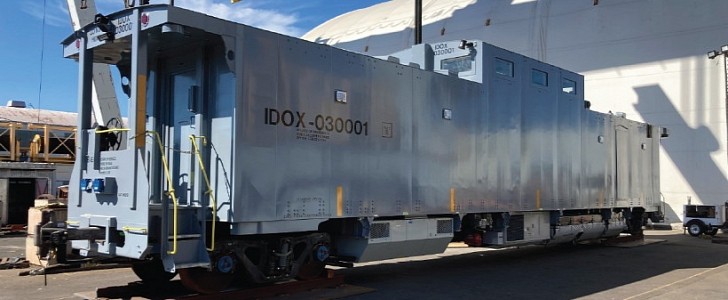What would the U.S. Navy and the Department of Energy (DOE) have to do with railcar building? Well, these two are the only entities allowed to transport spent nuclear fuel, so they’re putting together a one-of-a-kind cargo train, based on the highest-ever safety standards, for this tough job.
The fuel that’s been used at nuclear power plants, called spent nuclear fuel, needs to be disposed of, but there’s currently no large-scale transportation system for it available in the U.S. This stuff has been accumulating for half a century, so the need to dispose of it is becoming a burning issue for the government.
DOE and the U.S. Navy, through its Naval Nuclear Propulsion Program (NNPP), are developing a transportation capability for this type of fuel (SNF) and high-level radioactive waste. This future train will be comprised of two locomotives, several Atlas railcars for SNF containers, two buffer railcars that will separate the personnel from the Atlas railcars, plus one special rail escort vehicle (REV).
An Atlas 12-axle railcar can carry 17 SNF containers, weighing from 82 to 210 tons, and will be joined by an eight-axle version called Fortis. The REV, on the other hand, is meant to transport the security personnel during the SNF shipment. It’s a high-tech railcar with advanced cameras and communications systems for top-level surveillance of the shipment while also providing a comfortable living environment for the crew onboard.
Each component of this train has to meet the Association of American Railroads’ highest safety standard, called S-2043. As a result, these unique railcars “can go over low-quality tracks at normal speeds better than any other railcar that’s ever been built in North America,” Patrick Schwab told FreightWaves. As the Atlas project manager for DOE’s Office of Nuclear Energy, Schwab explained that this high standard is meant to ensure a very low probability of derailment.
This is why each railcar had to undergo extensive testing. Now, DOE is gearing up to put them all together and start multiple-car testing. This will be done in Pueblo, Colorado, where the U.S. Department of Transportation’s Transportation Technology Center is located. The Atlas and the buffer railcars are already there, and the REV will arrive later this month from Oregon.
There’s still a long way to go, with this new train expected to become operational by 2024. Even then, things won’t advance too much because, according to Schwab, there’s still no designated destination for the SNF.
DOE and the U.S. Navy, through its Naval Nuclear Propulsion Program (NNPP), are developing a transportation capability for this type of fuel (SNF) and high-level radioactive waste. This future train will be comprised of two locomotives, several Atlas railcars for SNF containers, two buffer railcars that will separate the personnel from the Atlas railcars, plus one special rail escort vehicle (REV).
An Atlas 12-axle railcar can carry 17 SNF containers, weighing from 82 to 210 tons, and will be joined by an eight-axle version called Fortis. The REV, on the other hand, is meant to transport the security personnel during the SNF shipment. It’s a high-tech railcar with advanced cameras and communications systems for top-level surveillance of the shipment while also providing a comfortable living environment for the crew onboard.
Each component of this train has to meet the Association of American Railroads’ highest safety standard, called S-2043. As a result, these unique railcars “can go over low-quality tracks at normal speeds better than any other railcar that’s ever been built in North America,” Patrick Schwab told FreightWaves. As the Atlas project manager for DOE’s Office of Nuclear Energy, Schwab explained that this high standard is meant to ensure a very low probability of derailment.
This is why each railcar had to undergo extensive testing. Now, DOE is gearing up to put them all together and start multiple-car testing. This will be done in Pueblo, Colorado, where the U.S. Department of Transportation’s Transportation Technology Center is located. The Atlas and the buffer railcars are already there, and the REV will arrive later this month from Oregon.
There’s still a long way to go, with this new train expected to become operational by 2024. Even then, things won’t advance too much because, according to Schwab, there’s still no designated destination for the SNF.






